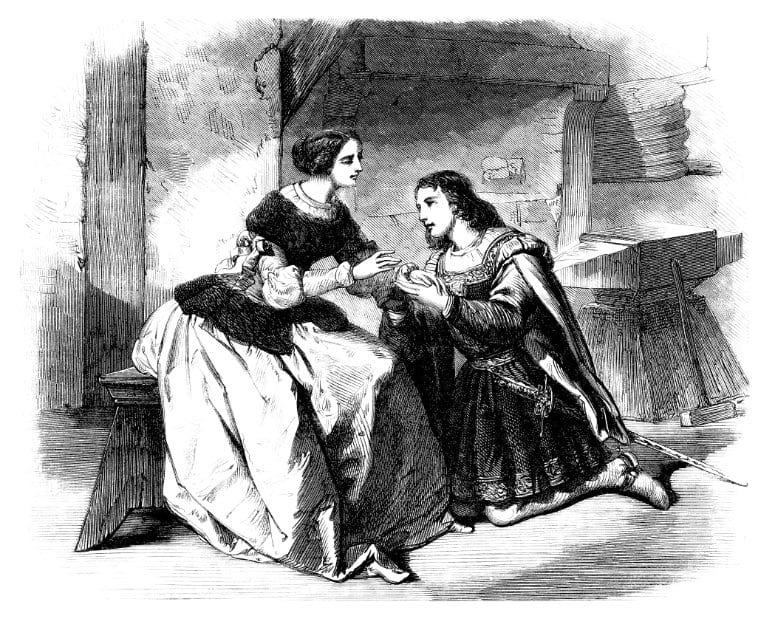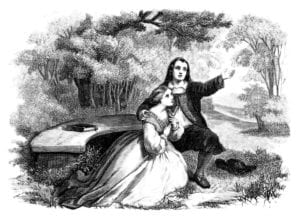The Shadow of the Reformation
From Henry VIII’s dissolution of the monasteries in the late 1530s to the Pope’s excommunication of Queen Elizabeth in 1570, conflict with Rome was a staple ingredient of sixteenth-century English life and politics. Shakespeare grew up in the shadow of this tension triggered by the Reformation, with Stratford particularly affected, a centre of Catholic recusancy.
In his writing Shakespeare carefully avoids this minefield, yet conflict with Rome does feature intermittently. In ‘Cymbeline’, for example, Celtic Britain is invaded by a Roman army – an assault it successfully repulses – while in ‘King John’ the English King is excommunicated by the Catholic Church as punishment for appointing a Cardinal not to Rome’s liking.
Elsewhere, various Cardinals (like Wolsey in ‘Henry VIII’) and Friars (like Lawrence in ‘Romeo and Juliet’) prove either venal or inept, while Joan of Arc – a Catholic saint – is presented in ‘Henry VI Part One’ as dishonest and promiscuous – a representation said to have been particularly resented by nineteenth-century audiences.
The Succession after Elizabeth
Along with the Reformation, the question of the Succession provided a second dark cloud in sixteenth-century England’s sky. The country, after all, was an absolute monarchy that depended for its continuity on the Queen choosing a husband and producing at least one surviving child.
The matter of the Succession was not open to public discussion, however. When a pamphlet was published enjoining the Queen not to marry into the French Royal Family, its author John Stubbs was incarcerated in the Tower of London and had his right hand cut off.
As many as half of Shakespeare’s plays are concerned in one way or another with the transfer of power. Monarchs may be poisoned (‘Hamlet’), stabbed in their beds (‘Macbeth’), or thrown into jail and murdered (‘Richard II’, ‘Henry VI’), they may be killed in battle (‘Richard III’), or they may simply be the victim of a palace coup (‘The Tempest’, ‘As You Like It’). Behind the drama may be sensed an authorial unease about the future.
‘The Governance of the Estate’ (1559)
It is a curious anomaly that England’s national poet should have written so little that bears directly on his homeland. Indeed, other than the History plays, only one play by Shakespeare is set in England: ‘The Merry Wives of Windsor’.
But in practice Shakespeare was simply obeying the law of the land. As early as 1559, a year into the reign of the new Queen, a proclamation was issued which forbade plays from dealing with ‘matters of religion or of the governance of the estate of the Commonweal’ – subjects, it seems, fit only for ‘men of authority, learning and wisdom’ and wholly unsuitable for ‘any audience but of grave and discreet persons’.
As a result, Shakespeare is careful to avoid contemporary events in his plays. True, there are one or two exceptions: a reference in ‘Henry V’ to the Earl of Essex ‘Bringing rebellion broached on his sword’ following a military campaign in Ireland, for example, or the Porter’s drunken thoughts on the Roman Catholic practice of ‘equivocation’ in ‘Macbeth’. But such references are few and far between.
In fairness, ‘The Merry Wives of Windsor’ (a light comedy said to have been written at the request of the monarch) steers well clear of the kind of material likely to appeal to ‘men of authority, learning and wisdom’.
Shakespeare’s Antecedents
Shakespeare’s grandfather Richard (1490 – 1561) was a tenant farmer near Stratford who wed above his station, marrying Abigail Webb, the daughter of the landowner from whom he rented his farm. The ability to ‘marry up’ seems to have been inherited by his son John (1531 – 1601), who married Mary Arden (1540 – 1608), daughter of another Stratford landowner from a family with distant aristocratic connections.
John subsequently embarked on a career as a glove-maker and local politician, among other activities. One of these was usury, or money-lending. Is it significant that this is also Shylock’s trade? Did this affect Shakespeare’s (intermittently) sympathetic presentation of Shylock? And is it worth noting that Arden is also the name of the forest in ‘As You Like It’, a place of refuge for Rosalind, where the pressures of life in the palace are forgotten and love flourishes?
Marrying Up in Shakespeare
A remarkably high proportion of the marriages and romances depicted by Shakespeare are cross-cultural: Desdemona with Othello and Antony with Cleopatra are only the tip of a large iceberg. Similarly common are marriages that straddle divisions between classes – often (though not always) with the female marrying up.
Helena in ‘All’s Well’ is a case in point: the daughter of a doctor, she is initially rejected as too middle-class for Bertram, though she wins him in the end; Florizel and Perdita in ‘The Winter’s Tale’ seem to be similarly divided by class, though Perdita’s royal heritage ultimately emerges.
Similar divisions might be expected to separate Touchstone from Audrey in ‘As You Like It’, but they splice the knot regardless and hope for the best; meanwhile Edward IV marries Elizabeth Woodville in ‘Henry VI Part Three’ – a love match that costs him the support of key allies like Warwick.
Curiously, Shakespeare’s earliest work may have drawn on this very dynamic: in ‘Arden of Feversham,’ a play on which the young playwright is believed to have collaborated, the lower-class Mosbie conspires to murder his social superior Arden in order to marry his wife Alice. Arden is duly killed, before Mosbie and Alice are sentenced to die for their crimes.
Shakespeare’s Dates
Shakespeare is widely believed to have been born on St George’s Day, April 23rd – the day on which, by coincidence, he died 52 years later.
In practice, however, the date of his birth cannot be definitively confirmed: what is known is that he was baptised on April 26th, and that (in deference to the high rates of child mortality), baptisms usually took place within two days of birth.
By contrast, the date of his death can be accepted as the 23rd, said to have been caused by a chill contracted while carousing with (among others) the playwright Ben Jonson.
Shakespeare’s Childhood
Shakespeare was born in the spring of 1564, just as the plague arrived in Stratford. His father later became Mayor of Stratford – among other activities, not all of them legal. William himself was the oldest of the six surviving children, followed by Gilbert, Joan, Anne (who died aged 8), Richard and Edmund. Two girls, Joan and Margaret, had been born before him, though neither survived infancy.
It seems that Richard and Edmund both followed their older brother to London, though only Edmund made his career in the theatre, acting (it is said) in some of William’s plays. It is surely no more than co-incidence that the villainous usurping monarch that caught Shakespeare’s eye was called Richard, and that the odious half-brother in ‘King Lear’ who seeks to deprive Edgar of his inheritance is given the name Edmund.
Siblings in Shakespeare’s Plays
Shakespeare’s exploration of fathers and daughters has been widely noted by critics. Examples include Lear’s relationship with his three daughters, Prospero’s with Miranda in ‘The Tempest’, Brabantio with Desdemona in ‘Othello’, Capulet with Juliet, Polonius with Ophelia in ‘Hamlet’ and many others: it is among his most familiar themes.
Less has been said about the picture Shakespeare paints of brotherly love. Yet around one third of his plays depict either brothers and sisters (Laertes and Ophelia in ‘Hamlet’, Viola and Sebastian in ‘Twelfth Night’) or brothers and brothers (Edgar with Edmund in ‘King Lear’, Richard III with Clarence). Most of Shakespeare’s depictions of the brother / brother relationship take a negative view – siblings often falling out over power (‘The Tempest’, ‘Hamlet’, ‘As You Like It’).
As mentioned above, Shakespeare himself was the oldest of six surviving children, four of them brothers.
A Note on Nominative Indeterminism
The name of Shakespeare is among the most familiar and revered of all surnames. Yet it has been subject to a wide range of variations over the years – quite apart from the fact that, to judge from the surviving signatures, the poet himself spelt it in a range of different ways.
One contentious variation appears to crop up in the will of Alexander Hoghton, a wealthy Lancastrian, who bequeathed to one ‘William Shakeshafte’ a year’s wages and a further £2: ‘it now seems clear’, writes Anthony Holden, ‘that this ‘Shakeshafte’ was in fact fifteen-year-old William Shakespeare’.
Further variations abound: once established as a central figure in the London theatre industry, Shakespeare is denounced by the satirist Robert Greene as ‘an absolute Johannes factotum [Jack of all trades], … in his own conceit the only Shake-scene in a country’. A decade later, Will Kemp, once his colleague in the Lord Chamberlain’s Men, satirises Shakespeare’s alleged pretensions in his Nine Daies Wonder, describing him as ‘my notable Shakerags’.
Meanwhile the collaboration ‘Arden of Feversham’, to which Shakespeare appears to have contributed early in his London career, features two murderers, Black Will and Shakebag, of whom Shakebag is the more criminal. An early self-portrait, perhaps?
Shakespeare’s Happy Marriages
Shakespeare’s plays offer numerous examples of forthcoming weddings that may or may not lead to happy marriages. Beatrice and Benedick in ‘Much Ado’ may be heading for years of nuptial bliss, as might Imogen and Posthumus in ‘Cymbeline’. Touchstone and Audrey in ‘As You Like It’ seem less well suited, and the same might be said of Helena and Bertram in ‘All’s Well that Ends Well’.
But evidence of supportive married life – as opposed to weddings – in Shakespeare’s work is remarkably thin on the ground. We might possibly include in any list of the happily-married Claudius and Gertrude in ‘Hamlet’ (though the evidence is thin), along with Caesar and Calpurnia in ‘Julius Caesar’ on the basis of one conversation. ‘The Taming of the Shrew’ might be a better bet, though Petruchio’s treatment of Katherina is not easy for modern eyes to accept.
Supportive married life is probably best exemplified by Macbeth and his wife – said to enjoy (in the words of the distinguished critic Harold Bloom) ‘the happiest marriage in Shakespeare’. She knows him very well, and is quick to support him – for example when Banquo’s ghost appears in Act Three. Whether her influence over her husband – extensive, at times apparently irresistible – serves his best interests is another matter.
Marriage to Anne Hathaway (1582)
Shakespeare’s marriage to Anne Hathaway in 1582 is an isolated fixed point in his ‘lost years’ – the period early in his adult life about which we know little – but some aspects of it are unusual, others open to dispute.
First, the name of Shakespeare’s intended is entered in the records at Worcester as Anne Whateley – almost certainly a clerical error. Second, she is recorded as a native of Temple Grafton when Anne Hathaway was a native of Shottery.
The licence has been lost but the marriage bond – a kind of insurance for the church – was set at £40, the equivalent of around £20,000 today, an extraordinary sum. Anne (or Agnes, as her father’s will describes her) was famously pregnant at the time of her marriage (see below).
Shakespeare himself, incidentally, is entered in the records as ‘Shagspere’: a further case of nominative variation afflicting this most renowned of names.
Anne Hathaway’s Pregnancy
Shakespeare was one of only three Stratford males between 1570 and 1630 to have married before the age of twenty – he was eighteen – and the only one (according to critic Stanley Wells) whose wife was pregnant at the time.
How far Shakespeare himself regretted the circumstances of his marriage may perhaps be inferred from a speech delivered in ‘the Tempest’ by Prospero to Ferdinand on the subject of Miranda’s virginity: ‘If thou dost break her virgin-knot before / All sanctimonious ceremonies may / With full and holy rite be minister’d,’ Prospero warns the young man, ‘No sweet aspersion shall the heavens let fall / To make this contract grow: but barren hate …’.
‘The Tempest’ was written in 1611, when Shakespeare’s oldest daughter Susanna was in her late twenties.
Shakespeare’s ‘Lost Years’ (1585 – 1590)
How Shakespeare spent the ‘lost years’ during the second half of the 1580s has long been a source of speculation. His marriage to Anne Hathaway in 1582 is a matter of (ambiguous) record as mentioned earlier, and he becomes father to Susanna the following year. Twins Judith and Hamnet were born in 1585. Then the trail goes cold.
Did Shakespeare train as a lawyer during the years before he emerges as an actor and playwright in his late twenties? His use of legal language in the plays – and some sonnets – suggests he might have done. Moreover, there are plenty of trial scenes in his plays too: ‘The Merchant of Venice’ of course, and ‘The Winter’s Tale’, as well as Catherine of Aragon’s trial in ‘Henry VIII’ and the murder trial in the collaboration ‘Arden of Feversham’. There are many accounts describing how these years were spent, though we shall probably never know the full story.
‘A Schoolteacher in the Country’
There are numerous theories (as mentioned earlier) about Shakespeare’s life in the early days of his marriage to Anne Hathaway. One traditional view has him working as a ‘schoolteacher in the country’, and if this is accurate, then the country in question may be Catholic Lancashire, where any affiliations the young man may have retained to the old faith would have been less conspicuous.
According to one theory, Shakespeare may have been employed working as a private tutor to a wealthy Catholic family, using drama to reinforce religious teaching to his charges. This was a period when, among young Catholic men and some women, martyrdom was highly esteemed, but it may be that for this young man, the draw of the theatre exerted a stronger attraction.
Sadly this intriguing theory will probably never be proved or disproved: the ‘lost years’ are so called with good reason.




